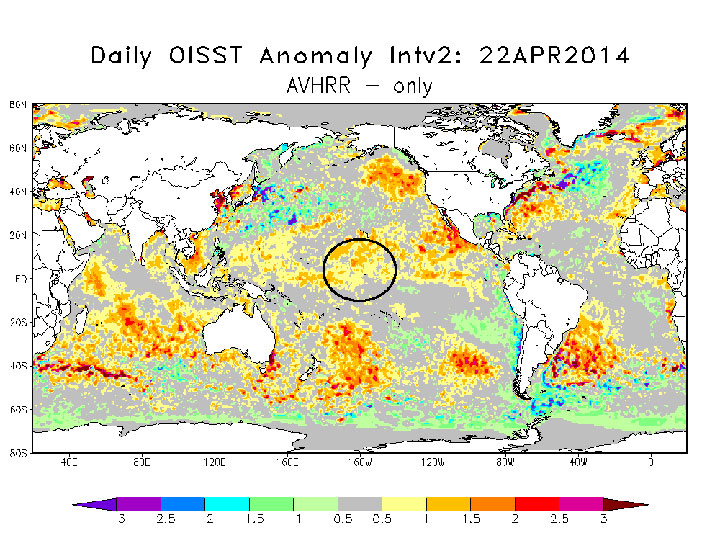TORONTO – Though we have endured colder-than-normal temperatures across the country, there is a chance that by the end of the year, we could see warmer-than-normal temperatures, thanks to a forecast of a major El Niño event.

READ MORE: Will this be Canada’s coldest winter?
An El Niño — Spanish for “little boy” — event occurs when warm water near Indonesia moves to the eastern Pacific. The effect of this change in ocean temperatures is felt far and wide — and not in the same way globally.
“The consensus is right now, according to NOAA’s Climate Prediction Center, that there is a better than 50 per cent chance that El Niño is going to occur later this summer or fall,” Jessica Blunden, a climatologist for the National Climate Data Center (NCDC), told Global News.
If there is a major El Niño event, it would bring significant weather pattern changes across North America.
“In terms of the winter, this winter was in fact, one of the coldest in 18 years in Canada, then…the good news is, next winter won’t be nearly as brutal,” Environment Canada’s Senior Climatologist David Phillips told Global News.
“In [an El Niño]…we tend to see more Pacific air than Arctic air, so the polar vortex won’t be thought of next year, other than as a distant memory.”
Gallery: The effects of an El Niño event
In 1997-1998, the world experienced the biggest El Niño event it had seen in 50 years. There were floods, landslides, drought and super typhoons in the Eastern Pacific. The winter in the United States was the second-warmest and seventh-wettest since 1895. The U.S. southeast endured major flooding.
As for Canada, the end of 1997 brought warmth and dry weather to Western Canada, but record snowfall in Atlantic Canada. Heading into 1998, Eastern Canada received the “Ice Storm of the Century.” It also gave us the second-mildest winter on record.
READ MORE: Research suggests climate change played role in Somalia’s 2011 famine, along with La Nina
Globally, the 1997-1998 El Niño killed an estimated 23,000 people and caused more than $33 billion in damage.
The area where climate scientists take readings to predict an El Niño or La Niña event (colder-than-normal ocean temperatures) is in a very specific region in the Pacific Ocean, dubbed the Niño 3.4. To calculate an El Niño event, she said, climatologists take “a three-month average of 0.5 C above the average temperature of the sea surface in a certain boxed region.”
“And these temperatures are beginning to warm.”
The Australian Bureau of Meteorology (BOM) uses a different method to forecast El Niño, specifically something called the Southern Oscillation Index which is correlated with the sea surface temperature. This index is based on observed sea level pressure differences in a region between Tahiti and Darwin, Australia. They, too, have determined that the world should prepare for an El Niño event.
On April 22, the BOM issued this overview of the state of the Pacific and Indian Ocean:
“The likelihood of El Niño remains high, with all climate models surveyed by the Bureau now indicating El Niño is likely to occur in 2014.”
“One of the things in North America, we tend to have wetter-than-average rainfall across the southern band of the United States,” Blunden said.
That would be a benefit to California, which has been going through one of the worst droughts in its history.
Though the rain will be welcome for the southern United States, and the warmth a welcome change following one of the most frigid winters Canada has seen in a long time, the southern hemisphere would likely see severe drought conditions in some areas.
READ MORE: Heavy rains stall search for victims of mudslide that buried half of Bolivian village
“El Niño has an impact across much of the world, including below average rainfall in the western Pacific and Indonesian regions, and increased rainfall in the central and eastern Pacific,” the BOM said in its overview. “For Australia, El Niño is usually associated with below average rainfall, with about two thirds of El Niño events since 1900 resulting in major drought over large areas of Australia.
El Niño and La Niña events are part of the El-Niño/Southern Oscillation (ENSO) cycle and occur fairly often.
The last El Niño occurred in 2009-2010 and caused drought conditions in Australia and brought rains to California.
It’s still early to see whether or not this forecast will come to pass, but climatologists around the world continue to keep a close eye on Niño 3.4







Comments